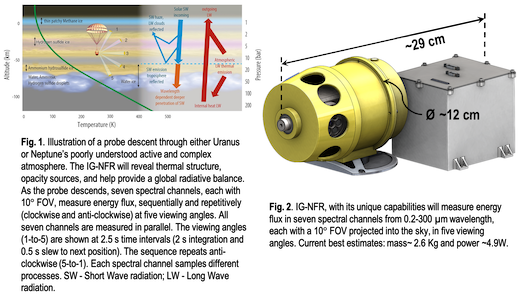Ice-Giants Net Flux Radiometer for Heat Flux Measurements
- 1NASA, Goddard Space Flight Center, Greenbelt MD, 20771, United States of America (shahid.aslam-1@nasa.gov)
- 2University of Oxford, Department of Atmospheric, Oceanic and Planetary Physics, Clarendon Laboratory, Oxford OX1 3PU, United Kingdom
- 3Catholic University of America, EECS, Washington DC, 20064, United States of America
We present the evolving design of an Ice-Giants Net Flux Radiometer (IG-NFR) [1][2][3], onboard a probe, Fig. 1, for in-situ measurements of the upward and downward heat flux in seven spectral channels as a function of altitude/pressure. These in situ probe measurements, will improve our understanding of energy balance and interior heat flux [4] and provide a reference profile to lift ambiguities inherent to remote observations [5].
The IG-NFR, Fig. 2, is designed to (i) accommodate seven filter bandpass channels (ii) measure up and down radiation flux in a 10° FOV for all channels in parallel; (iii) measure a change of flux of at least 0.5 W/m2 per decade of pressure; (iv) view five distinct view angles (±80°, ±45°, and 0°); (v) use application specific integrated circuit technology for the detector readout; (vii) be able to integrate radiance for 2 s or longer, and (vi) sample calibration targets every 19 s (assuming 100 m/s descent rate). Uncooled thermopile detectors are chosen for good detection sensitivity of radiation flux. A close hexagonal packing arrangement of Winston cones gives seven channels, with each Winston cone designed to give a 10° clear FOV. The Winston cone non-imaging optics, detectors and filters are all housed in a micro-vessel with CVD diamond and sapphire windows. The evacuated micro-vessel mitigates rapid excursions of temperature during the probe descent. A stepper motor with the aid of a gearbox rotates the micro-vessel, to each of the five view angles, so that the micro-vessel diamond windows have an unobstructed view through apertures in the mechanical enclosure into the atmosphere. The mechanical enclosure accommodates five apertures, hot and cold targets for radiometric calibration for each sequence of measurements (5-views).

[1] Aslam, S., et al., (2018). 49th Lunar and Planetary Science Conference 2018, The Woodlands, Texas, USA, Volume: LPI Contrib. No. 2083, 2675
[2] Aslam, S., et al., (2019). International Planetary Probe Workshop 2019, Oxford, UK
[3] Aslam, S., et al., (2020). Space Science Reviews, 216(1)
[4] Irwin, P. G. J., et al., (2020). EPSC 2020-306, online
[5] Mousis, O., et al., (2018). Planetary and Space Science 155:12-40
How to cite: Aslam, S., Calcutt, S., Gorius, N., Irwin, P., Nehmetallah, G., Quilligan, G., and Tran, D.: Ice-Giants Net Flux Radiometer for Heat Flux Measurements, European Planetary Science Congress 2021, online, 13–24 Sep 2021, EPSC2021-144, https://doi.org/10.5194/epsc2021-144, 2021.

